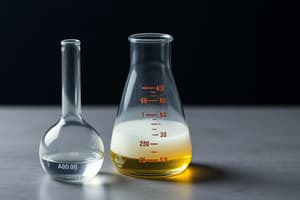Podcast
Questions and Answers
Over the past century, levels of what gas have been rising?
Over the past century, levels of what gas have been rising?
- Methane (correct)
- Oxygen
- Nitrogen
- Carbon Dioxide
What is one source of methane?
What is one source of methane?
- Burning fossil fuels
- Breakdown of plant materials by certain bacteria in rice paddies (correct)
- Deforestation
- Volcanic eruptions
Which of the following is a known source of methane?
Which of the following is a known source of methane?
- Sandy soil
- Wet, oxygen-poor soil (correct)
- Fertile soil
- Dry, oxygen-rich soil
What organisms' biological activity contributes to methane production?
What organisms' biological activity contributes to methane production?
In what part of cows do biochemical reactions produce methane?
In what part of cows do biochemical reactions produce methane?
What is another name for nitrous oxide?
What is another name for nitrous oxide?
How does nitrous oxide form?
How does nitrous oxide form?
How much has methane increased per year recently?
How much has methane increased per year recently?
How much is nitrous oxide rising annually?
How much is nitrous oxide rising annually?
Where does nitrous oxide form
Where does nitrous oxide form
Which of these gases is produced in the stomachs of cows?
Which of these gases is produced in the stomachs of cows?
Which of these contribute to the production of Methane?
Which of these contribute to the production of Methane?
Which gas has levels that have been rising over the past century?
Which gas has levels that have been rising over the past century?
Which of the following is NOT a source of methane?
Which of the following is NOT a source of methane?
What type of bacteria is involved in the production of methane in rice paddies?
What type of bacteria is involved in the production of methane in rice paddies?
What chemical compound forms in the soil?
What chemical compound forms in the soil?
What is the annual increase rate of nitrous oxide?
What is the annual increase rate of nitrous oxide?
Biochemical reactions in which animal's stomach produces methane?
Biochemical reactions in which animal's stomach produces methane?
What soil condition is conducive to methane production?
What soil condition is conducive to methane production?
Which gas is associated with rice paddies?
Which gas is associated with rice paddies?
Flashcards
Methane (CH4)
Methane (CH4)
A greenhouse gas whose levels have been increasing over the past century. Recently increasing by about 0.5 percent per year.
Sources of methane
Sources of methane
Breakdown of plant material by certain bacteria in rice paddies, wet oxygen-poor soil, the biological activity of termites and biochemical reactions in the stomachs of cows.
Nitrous oxide (N2O)
Nitrous oxide (N2O)
A greenhouse gas which has been rising annually at the rate of about one-quarter of a percent
Nitrous oxide formation
Nitrous oxide formation
Signup and view all the flashcards
Study Notes
Reaction Rate
- For a reaction 𝑎𝐴+𝑏𝐵→𝑐𝐶+𝑑𝐷, the rate can be expressed as: Rate = −(1/𝑎) * (𝑑[𝐴]/𝑑𝑡) = −(1/𝑏) * (𝑑[𝐵]/𝑑𝑡) = (1/𝑐) * (𝑑[𝐶]/𝑑𝑡) = (1/𝑑) * (𝑑[𝐷]/𝑑𝑡)
Rate Law
- Defines the relationship between reaction rate and reactant concentrations
- Expressed as: Rate = 𝑘[𝐴]^𝑥[𝐵]^𝑦, where:
- x is the order with respect to A
- y is the order with respect to B
- x + y is the overall reaction order
- k is the rate constant
Zero Order Reactions
- The rate is independent of the concentration of reactant A shown by Rate = 𝑘[𝐴]^0 = k
- Follows the equation: Rate = −(𝑑[𝐴]/𝑑𝑡) = 𝑘
- Integrated rate law: [A] = [A]₀ − 𝑘𝑡
- Half-life equation: 𝑡₁/₂ = [𝐴]₀ / 2𝑘
First Order Reactions
- Rate is directly proportional to the concentration of one reactant: Rate = 𝑘[𝐴]^1 = 𝑘[𝐴]
- Rate equation: Rate = −(𝑑[𝐴]/𝑑𝑡) = 𝑘[𝐴]
- The rate constant is independent from concentration
- Integrated rate law: ln[𝐴] = ln[𝐴]₀ − 𝑘𝑡 or ln([𝐴]/[𝐴]₀) = −𝑘𝑡 or [𝐴] = [𝐴]₀ * e^(−𝑘𝑡)
- Half-life equation: 𝑡₁/₂ = ln2 / 𝑘 = 0.693 / 𝑘
Second Order Reactions
- Rate is proportional to the square of the concentration of one reactant: Rate = 𝑘[𝐴]^2
- Rate equation: Rate = −(𝑑[𝐴]/𝑑𝑡) = 𝑘[𝐴]^2
- Integrated rate law: 1 / [𝐴] = 1 / [𝐴]₀ + 𝑘𝑡
- Half-life equation: 𝑡₁/₂ = 1 / 𝑘[𝐴]₀
Arrhenius Equation
- Describes the temperature dependence of reaction rates
- Expressed as: 𝑘 = 𝐴e^(−𝐸a/𝑅𝑇), where:
- k = rate constant
- A = frequency factor
- 𝐸a = activation energy
- R = gas constant (8.314 J/mol⋅K)
- T = temperature in Kelvin
- Logarithmic form of the Arrhenius equation: ln 𝑘 = ln 𝐴 − 𝐸a / 𝑅𝑇
Two-Point Arrhenius Equation
- Used to find the activation energy by using two experimental data points
- Equation: ln (𝑘₂/𝑘₁) = (𝐸a/𝑅) * (1/𝑇₁ − 1/𝑇₂)
Studying That Suits You
Use AI to generate personalized quizzes and flashcards to suit your learning preferences.




